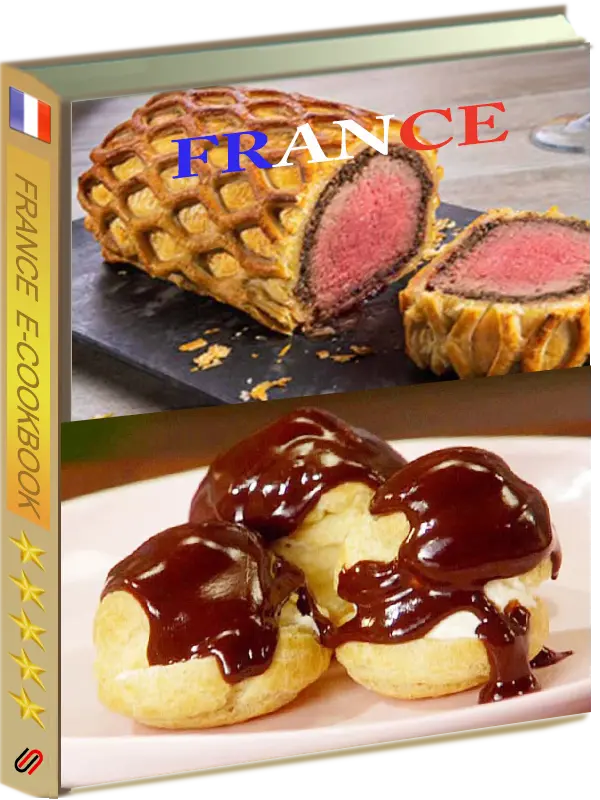The {Page-Turner-Cookbook} featuring
spices
Bagel seasoning mix
Baharat spice blend
Berbere - Ethiopian spice mix
Chinese five spice
Chipotle peppers in adobo sauce
Fish seasoning
Garam masala
Gochujang
Gomasio sesame salt
Nam jim thai dipping sauce
Namibian spice blend - kapana spice recipe
Rosemary oil
Seasoned flour and spices for fried chicken
Togarashi ichimi
Zaatar spice
Baharat spice blend
Berbere - Ethiopian spice mix
Chinese five spice
Chipotle peppers in adobo sauce
Fish seasoning
Garam masala
Gochujang
Gomasio sesame salt
Nam jim thai dipping sauce
Namibian spice blend - kapana spice recipe
Rosemary oil
Seasoned flour and spices for fried chicken
Togarashi ichimi
Zaatar spice
Weights
Top 5 countries
Last Page
togarashi ichimi Technically togarashi is a small, hot red Japanese chili available both fresh and dried, but its most popular use is as part of a traditional spice mix that commonly comprises seaweed, orange zest, ginger, sesame seeds, and chile powder. Though “spice mix” may call to mind Chinese five-spice or curry powder, togarashi, sometimes called ichimi, is often used as a finishing spice.
Aranya Black Pepper
Source: Pronounce It Button $12 Tasting Notes: Fig ∙ Citrus ∙ Jam ∙ Nutmeg We'd describe our beloved black pepper like a beautiful red wine - it's complex, layered, and deserves to be savored. Sometimes it feels like we've created a swarm of Aranya hoarders and evangelists, which makes sense because it truly makes every meal feel like a special occasion. Types of peppercorns Different types of peppercorns—green, black, and white—all start the same way, as a drupe, growing in clusters on a flowering vine of the plant Piper nigrum. That fruit, depending on how ripe it is when it’s harvested and how it’s processed, is what becomes the three types you’re most likely to come across in recipes. Green peppercorns Green peppercorns are harvested before they’re fully ripe, then either freeze-dried to a crushable texture or brined, which renders them almost caper-like. Brighter, milder, and more vegetal than black pepper, it is commonly used in Thai curries and gives a classic French steak au poivre its briny bite. Use green pepper in recipes like this Porterhouse With Summer Au Poivre Sauce, where pickled green peppercorns give a softer punch than black and bring chewy pops of texture. Black peppercorns The ubiquitous black peppercorn is also picked before it has reached full maturity. Unlike its green counterpart, it’s then blanched in hot water before being dried, which gives it that wrinkly, crackly skin. Despite their name, black peppercorns can range in color from silvery gray to chocolate brown to deep maroon. The flavor of the black peppercorns in your grinder has a lot to do with where they were grown and harvested, much in the same way that Chardonnay grapes from two different regions will yield distinctly different wines. And like wine, the distributors of high-quality pepper will often proudly tout its origins. Indian pepper from Malabar and Tellicherry, where it has been cultivated for millenia, tends to be sweet and fruity, with bright citrusy notes. Sarawak peppercorns from Malaysia lean more earthy and mild. Cambodian Kampot peppercorns can have a resiny, more astringent aroma like eucalyptus or menthol. -------------------- https://paraphrasing-tool.com/ We'd portray our darling dark pepper like a lovely red wine - it's intricate, layered, and should be enjoyed. Now and then it seems like we've made a multitude of Aranya hoarders and evangelists, which checks out in light of the fact that it really causes each dinner to feel like an extraordinary event. Peppercorns of various kinds The green, black, and white varieties of peppercorn all begin as drupes on a Piper nigrum flowering vine in clusters. That organic product, contingent upon how ready it is the point at which it's collected and the way that it's handled, turns into the three kinds you're probably going to go over in recipes. Green peppercorns Green peppercorns are reaped before they're completely ready, then, at that point, either freeze-dried to a crushable surface or tenderized, which renders them nearly escapade like. More brilliant, milder, and more vegetal than dark pepper, it is usually utilized in Thai curries and gives an exemplary French steak au poivre its briny nibble. Utilize green pepper in recipes like this Porterhouse With Summer Au Poivre Sauce, where cured green peppercorns give a gentler punch than dark and bring chewy pops of surface. Dark peppercorns The universal dark peppercorn is additionally picked before it has arrived at complete development. Dissimilar to its green partner, it's then, at that point, whitened in steaming hot water prior to being dried, which gives it that wrinkly, crackly skin. Notwithstanding their name, dark peppercorns can go in variety from shimmering dim to chocolate brown to profound maroon. The kind of the dark peppercorns in your processor has a great deal to do with where they were developed and reaped, much similarly that Chardonnay grapes from two unique districts will yield particularly various wines. Also, similar to wine, the merchants of great pepper will frequently gladly promote its starting points. Indian pepper from Malabar and Tellicherry, where it has been developed for millenia, will in general be sweet and fruity, with brilliant citrusy notes. Sarawak peppercorns from Malaysia incline more hearty and gentle. The aroma of Cambodian Kampot peppercorns can be more astringent and resinous than that of menthol or eucalyptus. --------------------- Where would we be without salt? James Beard Salt is what makes things taste bad when it is not in them. Irena Chalmer ------------- -------------- https://www.spiceography.com/list-of-herbs-and-spices/ asafoetida powder garam masala ras el hanout (le mélange pour couscous) ou des épices spéciales tajine. ras el hanout (le mélange pour couscous) ou des épices spéciales tajine. In Arabic Ras el Hanout literally means “the best of the grocery store”. This mixture of spices, in fact, represents one of the maximum oriental delicacies. Ras el Hanout is a spotlight in Moroccan and North African cuisines that could add a distinctive flavor to savory and sweet dishes. Ras el hanout was born in ancient times, even before the discovery of the Americas and when the spice trade was still ending in Morocco, the terminus of the African west. Couscous Moroccan cuisine Harissa Tajine Za'atar What are Chana Masala Spices? Garam masala adds warmth and richness to your meals with its amazing flavors. Experiment with different recipes and enjoy this spice mix! https://www.msn.com/en-ca/foodanddrink/foodnews/20-must-have-spices-and-what-to-do-with-them/ss-AA1k6Wpc?ocid=msedgntp&pc=LCTS&cvid=bd58b70a20cf4495b50ebdf928bb0965&ei=46 Chana Masala actually varies greatly in India depending on the area, and even down to the specific household. Each blend is unique. And that is what makes this fun! Here is a favorite blend which can be adapted to your own tastes. Cumin seeds (whole), garam masala, ground cumin, ground coriander, fennel seeds, paprika (or chili powder), dried fenugreek leaves, ground turmeric. Ajwain? Like coriander, cumin, and fennel, ajwain belongs to the Apiaceae (or Umbelliferae) family of plants. The shrub's leaves are feather-like and the plant's fruit—often referred to as seeds—are pale khaki-colored, ridged in texture, and oval-shaped. Ajwain has been used since ancient times in cooking and for medicinal purposes and is part of Indian, Middle Eastern, and African cooking What Is Cardamom? Cardamom is a spice made from the seed pods of various plants in the ginger family. Cardamom pods are spindle-shaped and have a triangular cross-section. The pods contain a number of seeds, but the entire cardamom pod can be used whole or ground. The seeds are small and black, while the pods differ in color and size by species. Varieties of Cardamom There are two main types of cardamom: black cardamom and green cardamom, and there is also white cardamom which is a bleached version of green cardamom. Green cardamom is the kind found most often in Nordic and Middle Eastern cuisine, while recipes in India and Asia will often specify whether green or black cardamom is used. Green cardamom (Elettaria cardamomom) is known as true cardamom. This is the most common variety you will see sold in the spice aisle of the supermarket. It is the top choice for sweet dishes but also works well in savory dishes. The bleached version, white cardamom, has less flavor. It is grown in tropical areas including India, Malaysia, and Costa Rica. Black cardamom (Amomum subulatum) has larger pods that are dark brown. It has a smoky element that makes it more appropriate for savory dishes, but it is used in sweet dishes as well in southern India. It is grown in the eastern Himalayas. Cardamom is found in Indian cooking as well as Middle Eastern cuisine. In Indian recipes, whole cardamom pods are used in preparing basmati rice and various curries. In Middle Eastern recipes, ground cardamom spices certain desserts. Nigella Seed? Nigella seed comes from the seeds of the flowering plant Nigella sativa, which is found throughout Turkey, Syria, and parts of Iraq. Nigella is sometimes referred to by other names, such as black cumin, black onion seed, and black sesame seed, which can lead to some confusion, as nigella is not related to any of these. Rather, it's a member of the Ranunculaceae family, which also includes flowers such as the buttercup and delphinium. What Does It Taste Like? Nigella seeds have a strong aroma and a flavor profile that has notes of onion, oregano, and black pepper. The perception of these flavors can differ from person to person, and some may taste a slightly nutty flavor as well. These characteristics contribute to why savory dishes make a great pair with these savory seeds. Cooking With Nigella Seed Nigella seeds are found frequently in Indian, Middle Eastern, and North African cuisines. This means you can find these seeds in curries and lentil dishes alike. Nigella seeds also pair well with root vegetable dishes, as well as squashes such as spiced butternut squash. Many Southern Asia meals can be found with Nigella sativa garnished on top or incorporated into their stir-fry. It's also used in making pilafs, curries, vegetable dishes, and pickles. A popular Bengal spice called panch phoron also includes nigella seeds along with other spices like fenugreek, mustard seed, fennel seed, and cumin seeds. A common use of nigella is in bread and pastries. Often in India, they mix nigella seeds into their traditional naan bread. There are many other unique ways to use nigella seeds; for instance, garnish on a salad for an extra crunch. One way to start using nigella seeds is to incorporate them into pancakes or scones. You can also use them much as you would use sesame seeds, like if you were making your own homemade crackers. They're also great sprinkled on eggs, in salad dressings, and since they pair well with dairy, they can be sprinkled on yogurt to add some flavor and crunch. One of the best ways to use nigella seeds is to sprinkle them on homemade breads or bagels before you bake them.
Aranya Black Pepper
is a premium variety of black pepper that is known for its complex and layered flavor profile. It has been described as having tasting notes of fig, citrus, jam, and nutmeg, and is often compared to a beautiful red wine due to its depth and savoriness1. This pepper is grown on the Parameswaran family farm in Kerala, India, where it is naturally farmed amidst a diverse ecosystem that includes passion fruit, tigers, and a vast collection of bamboo and palm varieties.
The pepper is vine ripened and hand harvested with great care to ensure maximum flavor and quality. It’s a blend of over 10 indigenous, wild, and heirloom pepper varieties, making it unique and versatile for various dishes2. Whether you’re making a classic dish like cacio e pepe or steak au poivre, or simply want to add a subtle kick to your dips and spreads, Aranya Black Pepper can elevate your cooking with its intense, concentrated flavor and fruity heat.
It’s a testament to the rich spice heritage of India and the dedication of farmers who prioritize sustainable and natural farming practices.
is a premium variety of black pepper that is known for its complex and layered flavor profile. It has been described as having tasting notes of fig, citrus, jam, and nutmeg, and is often compared to a beautiful red wine due to its depth and savoriness1. This pepper is grown on the Parameswaran family farm in Kerala, India, where it is naturally farmed amidst a diverse ecosystem that includes passion fruit, tigers, and a vast collection of bamboo and palm varieties.
The pepper is vine ripened and hand harvested with great care to ensure maximum flavor and quality. It’s a blend of over 10 indigenous, wild, and heirloom pepper varieties, making it unique and versatile for various dishes2. Whether you’re making a classic dish like cacio e pepe or steak au poivre, or simply want to add a subtle kick to your dips and spreads, Aranya Black Pepper can elevate your cooking with its intense, concentrated flavor and fruity heat.
It’s a testament to the rich spice heritage of India and the dedication of farmers who prioritize sustainable and natural farming practices.
Kimchi
Kimchi is a bit part of the national identity and is therefore served with pretty much every meal in South Korea. It’s usually made from fermented cabbage and chili, and it’s fair to say it’s a bit of an acquired taste for travellers.
Kimchi is a bit part of the national identity and is therefore served with pretty much every meal in South Korea. It’s usually made from fermented cabbage and chili, and it’s fair to say it’s a bit of an acquired taste for travellers.
Bagel seasoning mix 

The Bagel Seasoning is a perfect blend of sesame seeds, garlic, onion and salt.
1 1/2 tablespoons Poppy Seeds
2 tablespoons White Sesame Seeds
1 tablespoon Black Sesame Seeds
1 1/2 tablespoons Garlic (dried minced)
1 1/2 tablespoons Dried Onion Flakes
2 teaspoons Coarse Sea Salt (or flaked sea salt)
Serves: 8
Preparation time: 5 minutes
2 tablespoons White Sesame Seeds
1 tablespoon Black Sesame Seeds
1 1/2 tablespoons Garlic (dried minced)
1 1/2 tablespoons Dried Onion Flakes
2 teaspoons Coarse Sea Salt (or flaked sea salt)
1. In a mixing bowl or jar, combine all ingredients, until well mixed.
2. Store in an air-tight container, mason or shaker jar, and keep in your pantry.
3. Sprinkle over bagels, avocado toast, scrambled tofu, potatoes, homemade bread, salads, roasted veggies.
2. Store in an air-tight container, mason or shaker jar, and keep in your pantry.
3. Sprinkle over bagels, avocado toast, scrambled tofu, potatoes, homemade bread, salads, roasted veggies.
Baharat spice blend 
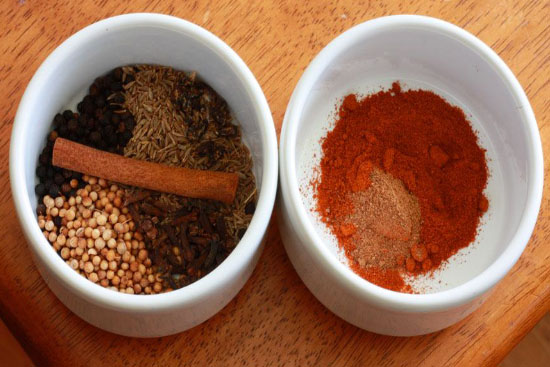
A popular Middle Eastern all-purpose spice blend.
1 tablespoon black peppercorns
1 tablespoon cumin seeds
2 teaspoons coriander seeds
1 teaspoon whole cloves
1/2 teaspoon cardamom seeds
1 1/2 tablespoons paprika
1 teaspoons ground cinnamon
1/4 teaspoon ground nutmeg
Serves: 24
Preparation time: 10 minutes
Cooking time:5 minutes
1 tablespoon cumin seeds
2 teaspoons coriander seeds
1 teaspoon whole cloves
1/2 teaspoon cardamom seeds
1 1/2 tablespoons paprika
1 teaspoons ground cinnamon
1/4 teaspoon ground nutmeg
Heat a small skillet over medium-high heat and dry roast the whole spices/seeds until they become very fragrant, about 3-5 minutes, tossing regularly to prevent scorching.
Transfer them to a bowl and allow them to cool completely before grinding them in a spice or coffee grinder along with the paprika, cinnamon and nutmeg. Keep stored in an airtight glass jar.
Transfer them to a bowl and allow them to cool completely before grinding them in a spice or coffee grinder along with the paprika, cinnamon and nutmeg. Keep stored in an airtight glass jar.
Berbere - Ethiopian spice mix 

Berbere is a chile and spice blend used to season many Ethiopian dishes. Because authentic berbere can be hard to find, here is therecipe.
1/2 teaspoon fenugreek
1/2 cup ground dried New Mexico chiles
1/4 cup paprika
1 tablespoon salt
1 teaspoon ground ginger
1 teaspoon onion powder
1/2 teaspoon ground cardamom
1/2 teaspoon ground coriander
1/4 teaspoon ground nutmeg
1/4 teaspoon garlic powder
1/8 teaspoon ground cloves
1/8 teaspoon ground cinnamon
1/8 teaspoon ground allspice
Preparation time: 15 minutes
1/2 cup ground dried New Mexico chiles
1/4 cup paprika
1 tablespoon salt
1 teaspoon ground ginger
1 teaspoon onion powder
1/2 teaspoon ground cardamom
1/2 teaspoon ground coriander
1/4 teaspoon ground nutmeg
1/4 teaspoon garlic powder
1/8 teaspoon ground cloves
1/8 teaspoon ground cinnamon
1/8 teaspoon ground allspice
Finely grind fenugreek seeds in an electric coffee/spice grinder. Stir together with remaining ingredients until combined well.
•Berbere keeps in an airtight container, chilled, 3 months.
•Berbere keeps in an airtight container, chilled, 3 months.
Chinese five spice 

Chinese five spice is a traditional Chinese spice blend used in many Chinese and Sichuan dishes.
4 star anise or use 1 tablespoons star anise powder
1 teaspoon fennel seeds or use 1 teaspoon ground fennel
1 teaspoon ground Szechuan pepper - use white pepper for milder flavor
1 3- inch stick Chinese cinnamon you can sub for other cinnamon - or use 1 teaspoon ground cinnamon
5 whole cloves or use 1/4 teaspoon ground cloves
Serves: 32
Preparation time: 5 minutes
Cooking time:2 minutes
1 teaspoon fennel seeds or use 1 teaspoon ground fennel
1 teaspoon ground Szechuan pepper - use white pepper for milder flavor
1 3- inch stick Chinese cinnamon you can sub for other cinnamon - or use 1 teaspoon ground cinnamon
5 whole cloves or use 1/4 teaspoon ground cloves
FOR WHOLE SPICES
Heat a large pan to medium-high heat. Add the whole seasonings and lightly toast them over dry heat, 1-2 minutes. Stir part way through. Be sure to not let the spices burn.
Remove from heat and transfer toasted spices to a spice grinder. Grind until well blended. You can also use a mortar and pestle to pulverize the ingredients by hand.
Use as desired. Store in a sealed container in a cool, dark place.
FOR GROUND SPICES
Mix the ingredients together until well combined. Use as desired. Store in a sealed container in a cool, dark place.
Heat a large pan to medium-high heat. Add the whole seasonings and lightly toast them over dry heat, 1-2 minutes. Stir part way through. Be sure to not let the spices burn.
Remove from heat and transfer toasted spices to a spice grinder. Grind until well blended. You can also use a mortar and pestle to pulverize the ingredients by hand.
Use as desired. Store in a sealed container in a cool, dark place.
FOR GROUND SPICES
Mix the ingredients together until well combined. Use as desired. Store in a sealed container in a cool, dark place.
Chipotle peppers in adobo sauce 
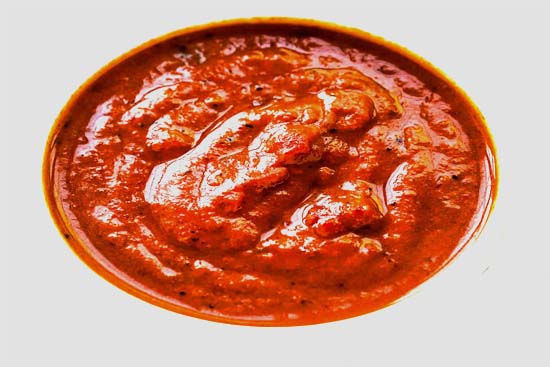
Serves: 8
Preparation time: 30 minutes
Cooking time:2 hours
1 cup tomato sauce
1 tsp honey
1 medium onion, thinly sliced
4 large garlic cloves, peeled and smashed
½ cup apple cider vinegar
½ tbsp peppercorns
Boil about four cups of water (enough to cover the peppers).
Place the dehydrated peppers in a large bowl and cover with the boiled water. Make sure that the peppers are submerged. You can use a plate or other weighty object to hold the peppers under the water. Let soak for 20 minutes; do not discard liquid.
Place 4 of the peppers into a blender or food processor with the tomato sauce, honey, and ½ cup of the soaking liquid. Blend until it is a soft paste.
In a medium saucepan, place the blended mixture along with the onion, garlic, cider vinegar, and peppercorns. Stir in enough of the reserved soaking liquid (or water) so that the onions are nearly submerged.
Simmer for about two hours. Periodically check on the mixture and stir if needed. If the liquid becomes too low, add more water. The consistency when everything is done and pureed should be like a soft paste .
Once it has simmered for two hours remove from heat. Place the whole mixture into a blender or food processor and puree until smooth. Be very careful when blending hot liquids; be sure that you don’t seal the lid while blending.
Can or freeze the peppers in small containers. They will keep for several months.
Place the dehydrated peppers in a large bowl and cover with the boiled water. Make sure that the peppers are submerged. You can use a plate or other weighty object to hold the peppers under the water. Let soak for 20 minutes; do not discard liquid.
Place 4 of the peppers into a blender or food processor with the tomato sauce, honey, and ½ cup of the soaking liquid. Blend until it is a soft paste.
In a medium saucepan, place the blended mixture along with the onion, garlic, cider vinegar, and peppercorns. Stir in enough of the reserved soaking liquid (or water) so that the onions are nearly submerged.
Simmer for about two hours. Periodically check on the mixture and stir if needed. If the liquid becomes too low, add more water. The consistency when everything is done and pureed should be like a soft paste .
Once it has simmered for two hours remove from heat. Place the whole mixture into a blender or food processor and puree until smooth. Be very careful when blending hot liquids; be sure that you don’t seal the lid while blending.
Can or freeze the peppers in small containers. They will keep for several months.
Fish seasoning 
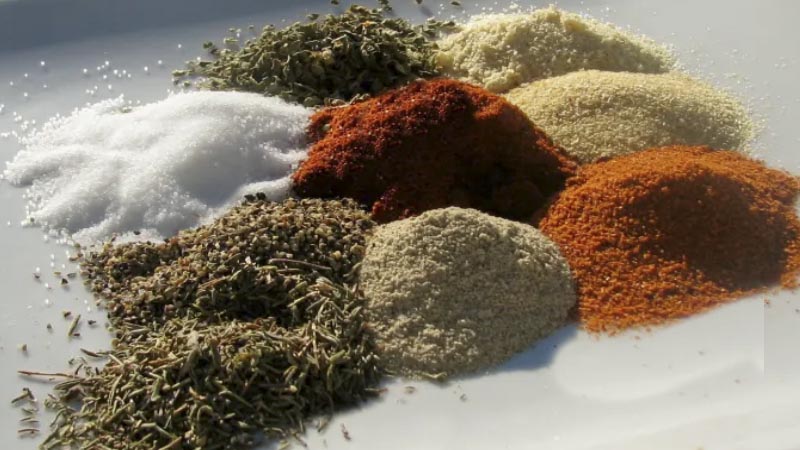
This is the original Paul Prudhomme’s Blackened Seasoning Spice; this Cajun seasoning made the New Orlean’s chef famous. Use this seasoning for your favorite seafood recipe.
1 tablespoon sweet paprika
1 teaspoon salt
1 teaspoon onion powder
1 teaspoon cayenne pepper
1 teaspoon garlic powder
1/2 teaspoon ground white pepper
1/2 teaspoon ground black pepper
1/2 teaspoon dry thyme leaves
1/2 teaspoon dry oregano
Serves: 20
Preparation time: 5 minutes
1 teaspoon salt
1 teaspoon onion powder
1 teaspoon cayenne pepper
1 teaspoon garlic powder
1/2 teaspoon ground white pepper
1/2 teaspoon ground black pepper
1/2 teaspoon dry thyme leaves
1/2 teaspoon dry oregano
Blend all ingredients together.
Seal in an air-tight container, and store in a dry place away from heat. Use with fish or seafood recipe.
Seal in an air-tight container, and store in a dry place away from heat. Use with fish or seafood recipe.
Garam masala 
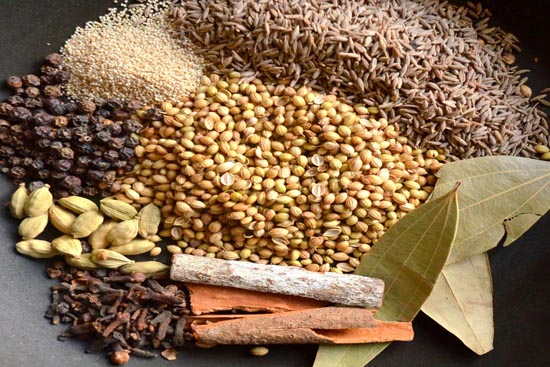
Garam masala will usually consist of:
Black pepper,
Coriander, Cumin, Cardamom, Cloves, Cinnamon (or cassia), Nutmeg
In variations on garam masala, ingredients may include:
turmeric,
saffron, fennel seeds, ginger, garlic,
mustard seeds,
mace, star anise, tamarind
fenugreek bay leaves
Malabar leaves
dried red chiles
Cooking With Garam Masala
Garam masala is usually added near the end of cooking so that it not only seasons the dish but adds to the aroma. Some additional garam masala may also be sprinkled on top of the dish. Traditionally, garam masala is made fresh from the component spices and used within a few days. It is often not the only spice and seasoning used in a dish.
2 tbsp ground coriander
2 tbsp ground cumin
1 tbsp ground turmeric
1 tsp red pepper flakes
2 tsp ground cinnamon
½ tsp ground black pepper
¼ tsp ground cardamom
¼ tsp ground nutmeg
Black pepper,
Coriander, Cumin, Cardamom, Cloves, Cinnamon (or cassia), Nutmeg
In variations on garam masala, ingredients may include:
turmeric,
saffron, fennel seeds, ginger, garlic,
mustard seeds,
mace, star anise, tamarind
fenugreek bay leaves
Malabar leaves
dried red chiles
Cooking With Garam Masala
Garam masala is usually added near the end of cooking so that it not only seasons the dish but adds to the aroma. Some additional garam masala may also be sprinkled on top of the dish. Traditionally, garam masala is made fresh from the component spices and used within a few days. It is often not the only spice and seasoning used in a dish.
Serves: 10
Preparation time: 5 minutes
2 tbsp ground cumin
1 tbsp ground turmeric
1 tsp red pepper flakes
2 tsp ground cinnamon
½ tsp ground black pepper
¼ tsp ground cardamom
¼ tsp ground nutmeg
Mix all the spices in a jar with a tight lid.
Store in your spice cabinet.
Alternatively you can buy whole coriander, cumin and cardamom seeds. Toast them in a dry pan until fragrant 2-4 minutes. Let them cool, grind the spices with a spice grinder, add the rest of the spices and store in a jar
Notes:
Garam masala is a blend of ground spices used extensively in Indian cuisine. The spices for garam masala are usually toasted to bring out more flavor and aroma, and then ground. The word "masala" means "spices," and garam means "hot." However, garam masala doesn't necessarily constitute a particularly spicy blend. and you will need to check the label to see what spices are included.
Varieties of Garam Masala
There is no single garam masala recipe. The ingredients differ according to the region as well as each chef's individual preferences. Garam masala from Northern India, including the Punjab region, often has only black pepper as a hot element and mostly focuses on aromatic and sweet spices. This garam masala will be quite mild, and any heat in the dish will come from adding hot peppers.
The farther south you go in India, the hotter the garam masala is likely to be as red chiles are likely to be part of the blend. The spices also change, based on what is more common locally.
What Does It Taste Like?
Garam masala adds warmth, sweetness, floral notes, and a touch of heat from the black pepper. It is intended to be a fragrant spice as well as flavorful. While cumin, coriander, and turmeric may remind you of curry, garam masala is generally not firey hot.
What Is It Made Of?
If you are buying garam masala, you will need to read the ingredients in order to determine which spices are is included.
Store in your spice cabinet.
Alternatively you can buy whole coriander, cumin and cardamom seeds. Toast them in a dry pan until fragrant 2-4 minutes. Let them cool, grind the spices with a spice grinder, add the rest of the spices and store in a jar
Notes:
Garam masala is a blend of ground spices used extensively in Indian cuisine. The spices for garam masala are usually toasted to bring out more flavor and aroma, and then ground. The word "masala" means "spices," and garam means "hot." However, garam masala doesn't necessarily constitute a particularly spicy blend. and you will need to check the label to see what spices are included.
Varieties of Garam Masala
There is no single garam masala recipe. The ingredients differ according to the region as well as each chef's individual preferences. Garam masala from Northern India, including the Punjab region, often has only black pepper as a hot element and mostly focuses on aromatic and sweet spices. This garam masala will be quite mild, and any heat in the dish will come from adding hot peppers.
The farther south you go in India, the hotter the garam masala is likely to be as red chiles are likely to be part of the blend. The spices also change, based on what is more common locally.
What Does It Taste Like?
Garam masala adds warmth, sweetness, floral notes, and a touch of heat from the black pepper. It is intended to be a fragrant spice as well as flavorful. While cumin, coriander, and turmeric may remind you of curry, garam masala is generally not firey hot.
What Is It Made Of?
If you are buying garam masala, you will need to read the ingredients in order to determine which spices are is included.
Gochujang 
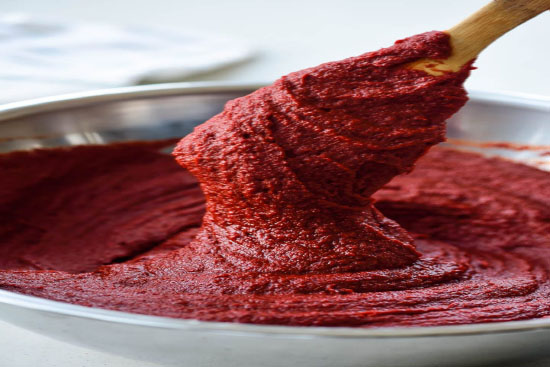
What is gochujang? Gochujang is a sweet and spicy Korean fermented red chili paste made from chili powder, glutinous rice, fermented soybean powder, barley malt powder, and salt. It is thick and pungent in flavor, adding a zingy depth to your dishes.
Gochujang (고추장), Korean fermented chili pepper paste, is one of the primary Korean seasoning and flavoring ingredients. The red thick paste is deeply savory, peppery, pungent, slightly sweet and spicy! No wonder everything tastes better with gochujang!
Traditionally homemade, gochujang is made of gochugaru (Korean red chili peppers), sweet syrupy liquid made with yeotgireum (엿기름, malt barley), meju garu (fermented soybean powder), sweet rice or other grain powder, and salt. These ingredients are mixed well to a thick paste and placed in earthenware pots to ferment for months.
500 grams yeotgireum (엿기름) (Barley malt powder)
500 grams wet chapssal garu (찹쌀) - sweet rice flour or 2 cups sweet rice soaked and blended
250 grams meju garu (메주가루), fermented soybean powder
250 grams Korean Cheonilyeom (천일염) coarse sea salt (bittern removed)
500 grams finely ground gochugaru, 고추가루 - Gochugaru is made from bright red Korean chile peppers with the seeds and membranes removed
1 cup jocheong (조청), rice syrup - optional or masilcheong (Korean green plump syrup)
How to make gochujang at home as explained here by Hyosun on the following site:
https://www.koreanbapsang.com/how-to-make-gochujang/
Here, I’m sharing how to make gochujang the traditional way my mother used to make.
Place the barley malt in a large bowl. Stir in 10 cups of warm water, and let it sit for an hour or two, up to overnight.
- How to Make Gochujang
Rub the malt between palms and squeeze out milky liquid. Strain the malt liquid through a fine sieve into another bowl. If you don’t have a fine sieve, line a strainer with a cheesecloth. Then, squeeze the malt husks with your hands through the sieve to drain out the remaining liquid. Transfer the liquid to a large heavy bottom pot.
- How to Make Gochujang
Place the malt husks in the first bowl and add another 10 cups of water. No need for an additional soaking time. Repeat the squeezing and straining process. Transfer the liquid to the pot with the first batch of milky liquid. This will yield about 17 to 18 cups of malt water.
4
Add the sweet rice powder to the malt water and stir well. Turn the heat on to warm it up. Warm but not too hot to touch. Turn the heat off, and let it sit for two hours. During this process, the enzymes in the malt will break down the starch in sweet rice and convert to sugar.
Turn the heat on to medium and boil the liquid down to a half, stirring once in a while. Measure the depth of the liquid with a wooden spoon or spatula, so you can easily tell when the liquid is reduced to a half. This will take about 2 hours and the resulting liquid will be around 8 to 9 cups. You’ll need about 8 cups for this recipe, but a little bit of extra is nice to have just in case. If you're using other optional liquid, you can reduce it further. Stir once in a while. Let it cool down a bit.
While the liquid is still warm, pour 7 cups of the malt liquid into a large bowl, and add the salt. If you're not using Korean sea salt, hold some back and add as necessary after mixing dry ingredients. Stir to dissolve. This is about a cup less than what’s required so you can add the rest or optional ingredients as needed.
Using a whisk, stir in the fermented soybean powder and mix well until you see no lumps.
Stir-in the gochugaru and mix very well until there are no big lumps. Continue to stir. You can use a large wooden spoon or spatula this time. If the gochujang is too thick, use more malt liquid or optional rice syrup (jocheong), plum extract, and/or soju to adjust the thickness and sweetness. It should be thin enough to slowly drop from the wooden spoon or spatula like a thick batter. Let it sit for a few hours until the dry ingredients fully absorb the liquid, and salt is completely melted. Adjust the saltiness, sweetness, and thickness as necessary. Gochujang should be a bit too salty to eat as is.
Transfer to a jar(s) or an earthenware -- onggi hangari, if you have one. Lightly sprinkle with coarse sea salt. Cover with a fine mesh fabric or cheesecloth and secure with a rubber band.
Gochujang (고추장), Korean fermented chili pepper paste, is one of the primary Korean seasoning and flavoring ingredients. The red thick paste is deeply savory, peppery, pungent, slightly sweet and spicy! No wonder everything tastes better with gochujang!
Traditionally homemade, gochujang is made of gochugaru (Korean red chili peppers), sweet syrupy liquid made with yeotgireum (엿기름, malt barley), meju garu (fermented soybean powder), sweet rice or other grain powder, and salt. These ingredients are mixed well to a thick paste and placed in earthenware pots to ferment for months.
Serves: 20
Preparation time: 4 hours
Cooking time:2 hours
500 grams wet chapssal garu (찹쌀) - sweet rice flour or 2 cups sweet rice soaked and blended
250 grams meju garu (메주가루), fermented soybean powder
250 grams Korean Cheonilyeom (천일염) coarse sea salt (bittern removed)
500 grams finely ground gochugaru, 고추가루 - Gochugaru is made from bright red Korean chile peppers with the seeds and membranes removed
1 cup jocheong (조청), rice syrup - optional or masilcheong (Korean green plump syrup)
How to make gochujang at home as explained here by Hyosun on the following site:
https://www.koreanbapsang.com/how-to-make-gochujang/
Here, I’m sharing how to make gochujang the traditional way my mother used to make.
Place the barley malt in a large bowl. Stir in 10 cups of warm water, and let it sit for an hour or two, up to overnight.
- How to Make Gochujang
Rub the malt between palms and squeeze out milky liquid. Strain the malt liquid through a fine sieve into another bowl. If you don’t have a fine sieve, line a strainer with a cheesecloth. Then, squeeze the malt husks with your hands through the sieve to drain out the remaining liquid. Transfer the liquid to a large heavy bottom pot.
- How to Make Gochujang
Place the malt husks in the first bowl and add another 10 cups of water. No need for an additional soaking time. Repeat the squeezing and straining process. Transfer the liquid to the pot with the first batch of milky liquid. This will yield about 17 to 18 cups of malt water.
4
Add the sweet rice powder to the malt water and stir well. Turn the heat on to warm it up. Warm but not too hot to touch. Turn the heat off, and let it sit for two hours. During this process, the enzymes in the malt will break down the starch in sweet rice and convert to sugar.
Turn the heat on to medium and boil the liquid down to a half, stirring once in a while. Measure the depth of the liquid with a wooden spoon or spatula, so you can easily tell when the liquid is reduced to a half. This will take about 2 hours and the resulting liquid will be around 8 to 9 cups. You’ll need about 8 cups for this recipe, but a little bit of extra is nice to have just in case. If you're using other optional liquid, you can reduce it further. Stir once in a while. Let it cool down a bit.
While the liquid is still warm, pour 7 cups of the malt liquid into a large bowl, and add the salt. If you're not using Korean sea salt, hold some back and add as necessary after mixing dry ingredients. Stir to dissolve. This is about a cup less than what’s required so you can add the rest or optional ingredients as needed.
Using a whisk, stir in the fermented soybean powder and mix well until you see no lumps.
Stir-in the gochugaru and mix very well until there are no big lumps. Continue to stir. You can use a large wooden spoon or spatula this time. If the gochujang is too thick, use more malt liquid or optional rice syrup (jocheong), plum extract, and/or soju to adjust the thickness and sweetness. It should be thin enough to slowly drop from the wooden spoon or spatula like a thick batter. Let it sit for a few hours until the dry ingredients fully absorb the liquid, and salt is completely melted. Adjust the saltiness, sweetness, and thickness as necessary. Gochujang should be a bit too salty to eat as is.
Transfer to a jar(s) or an earthenware -- onggi hangari, if you have one. Lightly sprinkle with coarse sea salt. Cover with a fine mesh fabric or cheesecloth and secure with a rubber band.
Gomasio sesame salt 

Gomasio, which translates to “sesame salt”, is a Japanese seasoning blend made from whole sesame seeds and salt. A variation includes dried seaweed. Gomasio is a table condiment, often sprinkled over a variety of foods to add flavor and a touch of saltiness.
Gomasio has a very low ratio of salt so it is a perfect low sodium seasoning. When the sesame seeds are toasted their oils are released and coat the salt granules, boosting their flavor.
16 tbsp sesame seeds (you can even use black sesame seeds)
1 tbsp good quality mineral salt like Himalayan Salt,Guerande or Camargue fleur de sel from France
Gomasio has a very low ratio of salt so it is a perfect low sodium seasoning. When the sesame seeds are toasted their oils are released and coat the salt granules, boosting their flavor.
Serves: 12
Preparation time: 5 minutes
1 tbsp good quality mineral salt like Himalayan Salt,Guerande or Camargue fleur de sel from France
Gomasio is traditionally made with unhulled sesame seeds, meaning the outer layer is intact. This also adds a bit of bitterness. You can also use hulled sesame seeds if you prefer to cut back on the bitter flavor.
The sesame seeds are toasted until golden brown and left to cool before grinding them and combining them with the salt.
Use good sea salt such as flaky sea salt (Maldon Salt) because the flakes add a great texture to the seasoning blend.
Store the mix in a glass jar and keep in the fridge. Sprinkle over rice, steamed vegetables, salads or anything that wants a bit of extra seasoning and flavour on
Gomasio is traditionally made with unhulled sesame seeds, meaning the outer layer is intact. This also adds a bit of bitterness. You can also use hulled sesame seeds if you prefer to cut back on the bitter flavor. The sesame seeds are toasted until golden brown and left to cool before grinding them and combining them with the salt.
Consider this a very unique all-purpose seasoning blend. Here are just a few ways you can use it:
On rice, noodles and rice balls
Sprinkled on salads
In stir fries
Sprinkled on soups
With sushi and California rolls
Tossed in popcorn
Sprinkled over steamed vegetables and beans
The sesame seeds are toasted until golden brown and left to cool before grinding them and combining them with the salt.
Use good sea salt such as flaky sea salt (Maldon Salt) because the flakes add a great texture to the seasoning blend.
Store the mix in a glass jar and keep in the fridge. Sprinkle over rice, steamed vegetables, salads or anything that wants a bit of extra seasoning and flavour on
Gomasio is traditionally made with unhulled sesame seeds, meaning the outer layer is intact. This also adds a bit of bitterness. You can also use hulled sesame seeds if you prefer to cut back on the bitter flavor. The sesame seeds are toasted until golden brown and left to cool before grinding them and combining them with the salt.
Consider this a very unique all-purpose seasoning blend. Here are just a few ways you can use it:
On rice, noodles and rice balls
Sprinkled on salads
In stir fries
Sprinkled on soups
With sushi and California rolls
Tossed in popcorn
Sprinkled over steamed vegetables and beans
Nam jim thai dipping sauce 

Serves: 12
Preparation time: 15 minutes
1/4 cup garlic chopped
6 - 10 thai hot peppers chopped
3 tbsp coriander (cilantro) root and stems chopped
3 tbsp palm sugar substitute dark brown sugar if unavailable
2 tbsp fish sauce
2 tbsp oyster sauce
1 tbsp fresh ginger chopped
Prepare all ingredients and place in a food processor or blender and pulse to mix ingredients well , transfer into a bowl and cover, allow sauce to sit at room temperature for 1 to 2 hours, adjust ingredients to taste. Garnish with a few cilantro leaves or fresh green onions Store in a jar refrigerated for up to 2-3 weeks.
Namibian spice blend - kapana spice recipe 

Kapana spice is a spicy and flavorful Namibian spice blend, that's mostly used in many Namibian dishes such as kapana - grilled meat that's cut into strips.
Namibian all purpose BBQ spice blend:
1 tablespoon garlic powder
1 tablespoon onion powder
1/4 teaspoon ground coriander
1 tablespoon smoked paprika
1 tablespoon sweet paprika
1 teaspoon red pepper flakes
1 tablespoon dried thyme
1 teaspoon salt
1/2 teaspoon ground mustard
1/4 teaspoon ground cumin
1 tablespoon brown sugar
1 tablespoon ginger powder
1 teaspoon black pepper
Serves: 20
Preparation time: 5 minutes
1 tablespoon garlic powder
1 tablespoon onion powder
1/4 teaspoon ground coriander
1 tablespoon smoked paprika
1 tablespoon sweet paprika
1 teaspoon red pepper flakes
1 tablespoon dried thyme
1 teaspoon salt
1/2 teaspoon ground mustard
1/4 teaspoon ground cumin
1 tablespoon brown sugar
1 tablespoon ginger powder
1 teaspoon black pepper
Combine all the ingredients together.
The kapana spice mix will keep for months if stored in an airtight container in a cool and dry place.
Let the rub infuse for a few days for the flavors to meld together before using.
The kapana spice mix will keep for months if stored in an airtight container in a cool and dry place.
Let the rub infuse for a few days for the flavors to meld together before using.
Rosemary oil 

You must use dried herbs when making oils of any kind. The water in the herbs will turn the oil rancid and will create an opportunity for bacteria to grow, if using fresh cut herbs.
Makes 1 Pint Jar
1/2 cup dried rosemary
1.5 cups of good extra virgin olive oil, OR non-GMO avocado oil (or enough to fill the jar)
Olive oil dispenser
Serves: 10
Preparation time: 10 minutes
Cooking time:10 minutes
1/2 cup dried rosemary
1.5 cups of good extra virgin olive oil, OR non-GMO avocado oil (or enough to fill the jar)
Olive oil dispenser
Allow the rosemary to dehydrate completely before mixing. You can hang your herb bundles up, lay them on a cookie sheet or plate to dry. Or you can use your dehydrator. Once the herbs are dry and brittle it’s ready to use.
Chop herbs up into smaller pieces to they fit into the jar.
Pour chopped rosemary into the jar, and cover with oil until the jar is full. Make sure the jar is full to the top to avoid oxidation and discoloration.
Allow to sit at room temperature in a dark place for 4-6 weeks. A cupboard is a good place.
After the 4-6 weeks, you can strain the oil removing the spent herbs.
Store oil in a dark jar, preferably a dark colored, olive oil dispenser for ease of use. You can keep this on the counter next to your other oils for ease of access.
Rosemary oil (when completed as above) can last several weeks or months on the countertop. You will know your oil has gone rancid from its foul odor.
What is rosemary oil good for? Externally rosemary is known to help with hair loss and arthritic pain. Internally rosemary offers antioxidants, antimicrobial, and is even being researched for tumor suppression due to its Rosmarinic Acid content. Olive oil also has benefits, such as containing healthy fats, helping with inflammation, and offering antioxidants. When combined you can expect an oil to give you the best of both worlds.
Chop herbs up into smaller pieces to they fit into the jar.
Pour chopped rosemary into the jar, and cover with oil until the jar is full. Make sure the jar is full to the top to avoid oxidation and discoloration.
Allow to sit at room temperature in a dark place for 4-6 weeks. A cupboard is a good place.
After the 4-6 weeks, you can strain the oil removing the spent herbs.
Store oil in a dark jar, preferably a dark colored, olive oil dispenser for ease of use. You can keep this on the counter next to your other oils for ease of access.
Rosemary oil (when completed as above) can last several weeks or months on the countertop. You will know your oil has gone rancid from its foul odor.
What is rosemary oil good for? Externally rosemary is known to help with hair loss and arthritic pain. Internally rosemary offers antioxidants, antimicrobial, and is even being researched for tumor suppression due to its Rosmarinic Acid content. Olive oil also has benefits, such as containing healthy fats, helping with inflammation, and offering antioxidants. When combined you can expect an oil to give you the best of both worlds.
Seasoned flour and spices for fried chicken 
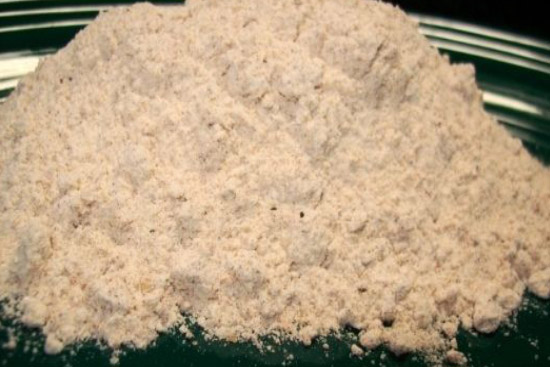
Use this flour mixture to coat and season your favorite fried chicken recipe.
3 cups sifted flour
1 teaspoon paprika
2 teaspoon garlic salt
2 teaspoons onion salt
1 teaspoon dried oregano
1 teaspoon dried sage
1/2 teaspoon dried powdered rosemary
1/2 teaspoon dried powdered thyme
1 teaspoon dried parsley
1 teaspoon salt
1 teaspoon ground black pepper
1/2 teaspoon Aromat seasoning.
Preparation time: 5 minutes
1 teaspoon paprika
2 teaspoon garlic salt
2 teaspoons onion salt
1 teaspoon dried oregano
1 teaspoon dried sage
1/2 teaspoon dried powdered rosemary
1/2 teaspoon dried powdered thyme
1 teaspoon dried parsley
1 teaspoon salt
1 teaspoon ground black pepper
1/2 teaspoon Aromat seasoning.
Combine all ingredients.
Togarashi ichimi 

Recipe makes about 1/2 cup
Technically togarashi is a small, hot red Japanese chili available both fresh and dried, but its most popular use is as part of a traditional spice mix that commonly comprises seaweed, orange zest, ginger, sesame seeds, and chile powder. Though “spice mix” may call to mind Chinese five-spice or curry powder, togarashi, sometimes called ichimi, is often used as a finishing spice.
2 tablespoons ground red pepper, such as ichimi togarashi or cayenne pepper
1 tablespoon granulated dried orange peel
1 tablespoon white sesame seeds and/or black sesame seeds
1 teaspoon hemp seeds and/or poppyseeds
1 teaspoon ground sansho peppercorns or Sichuan peppercorns
1 teaspoon nori flakes (cut from about ½ sheet nori, or sold as anori)
¼ teaspoon ground ginger
Technically togarashi is a small, hot red Japanese chili available both fresh and dried, but its most popular use is as part of a traditional spice mix that commonly comprises seaweed, orange zest, ginger, sesame seeds, and chile powder. Though “spice mix” may call to mind Chinese five-spice or curry powder, togarashi, sometimes called ichimi, is often used as a finishing spice.
Serves: 10
Preparation time: 10 minutes
1 tablespoon granulated dried orange peel
1 tablespoon white sesame seeds and/or black sesame seeds
1 teaspoon hemp seeds and/or poppyseeds
1 teaspoon ground sansho peppercorns or Sichuan peppercorns
1 teaspoon nori flakes (cut from about ½ sheet nori, or sold as anori)
¼ teaspoon ground ginger
Place all ingredients in a medium bowl, and whisk to combine.
Transfer the blend to an airtight container, and keep it in a cool, dry place.
Sprinkle a small amount on grilled meats, noodle soups, and more.
Transfer the blend to an airtight container, and keep it in a cool, dry place.
Sprinkle a small amount on grilled meats, noodle soups, and more.
Zaatar spice 
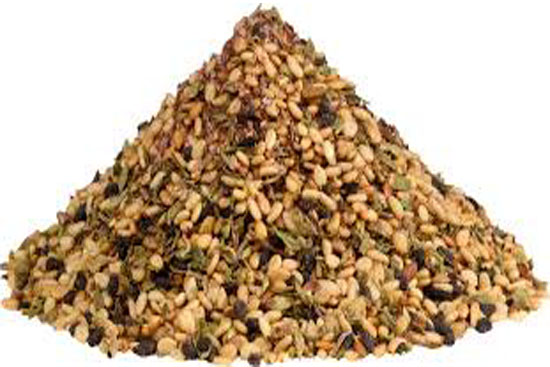
Good quality za’atar will smell sharp and almost spicy, with a rich nuttiness. If you detect a musty or rancid odor, shop elsewhere.
3 tbsp toasted sesame seeds
2 tbsp dried oregano
2 tbsp dried thyme
1 tbsp ground sumac
1 tsp sea salt
Serves: 10
Preparation time: 5 minutes
3 tbsp toasted sesame seeds
2 tbsp dried oregano
2 tbsp dried thyme
1 tbsp ground sumac
1 tsp sea salt
Stir all ingredients in a bowl and then partially crush using a pestle and mortar or a coffee mill. Don’t crush or mill the mixture too much; you want the end result to be slightly textured, with flecks of whole sesame seeds still visible.
sprinkle over baked pitas; hummus; grilled fish, poultry or meats; or whiske into salad dressings.
sprinkle over baked pitas; hummus; grilled fish, poultry or meats; or whiske into salad dressings.
conversion of liquids
Weights
Temperatures
Measures of non liquid ingredients
Non-liquid ingredients in volume converted
|
|||||||
|---|---|---|---|---|---|---|---|
Ingredient |
1 cup |
3/4 cup |
2/3 cup |
1/2 cup |
1/3 cup |
1/4 cup |
2 tablespoons |
| All-purpose wheat flour | 120 g | 90 g | 80 g | 60 g | 40 g | 30 g | 15 g |
| All-purpose sifted wheat flour | 110 g | 80 g | 70 g | 55 g | 35 g | 27 g | 13 g |
| White sugar | 200 g | 150 g | 130 g | 100 g | 65 g | 50 g | 25 g |
| Powdered sugar/Icing sugar | 100 g | 75 g | 70 g | 50 g | 35 g | 25 g | 13 g |
| Brown sugar normally packed | 180 g | 135 g | 120 g | 90 g | 60 g | 45 g | 23 g |
| Corn flour | 160 g | 120 g | 100 g | 80 g | 50 g | 40 g | 20 g |
| Cornstarch | 120 g | 90 g | 80 g | 60 g | 40 g | 30 g | 15 g |
| Rice (not-cooked) | 190 g | 140 g | 125 g | 95 g | 65 g | 48 g | 24 g |
| Macaroni (uncooked) | 140 g | 100 g | 90 g | 70 g | 45 g | 35 g | 17 g |
| Couscous (uncooked) | 180 g | 135 g | 120 g | 90 g | 60 g | 45 g | 22 g |
| Quick oatmeal (uncooked) | 90 g | 65 g | 60 g | 45 g | 30 g | 22 g | 11 g |
| Table salt | 300 g | 230 g | 200 g | 150 g | 100 g | 75 g | 40 g |
| Butter / Margarine | 240 g | 180 g | 160 g | 120 g | 80 g | 60 g | 30 g |
| Shortening | 190 g | 140 g | 125 g | 95 g | 65 g | 48 g | 24 g |
| Fruits and légumes chopped | 150 g | 110 g | 100 g | 75 g | 50 g | 40 g | 20 g |
| chopped walnuts | 150 g | 110 g | 100 g | 75 g | 50 g | 40 g | 20 g |
| Nuts /ground almonds | 120 g | 90 g | 80 g | 60 g | 40 g | 30 g | 15 g |
| Fresh bread crumbs (not packed) | 60 g | 45 g | 40 g | 30 g | 20 g | 15 g | 8 g |
| Dry bread crumbs | 150 g | 110 g | 100 g | 75 g | 50 g | 40 g | 20 g |
| Parmesan grated | 90 g | 65 g | 60 g | 45 g | 30 g | 22 g | 11 g |
| Chocolate chips | 150 g | 110 g | 100 g | 75 g | 50 g | 38 g | 19 g |
Last page
spices
{Page-Turner} E-Cookbooks Library
on a world cooking journey.
0 Appetizers
15 Main dishes
Side dishes
15
spices recipes






